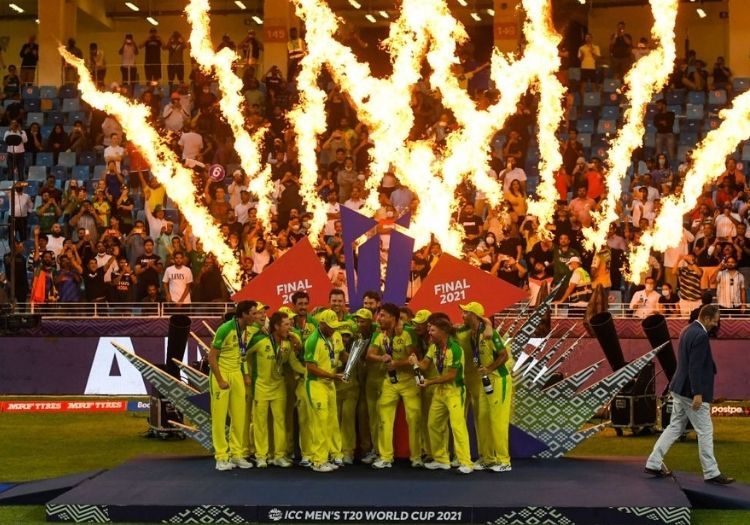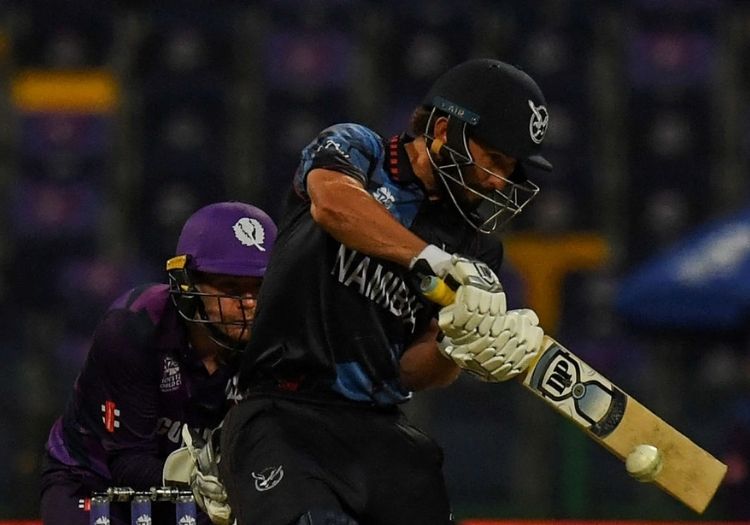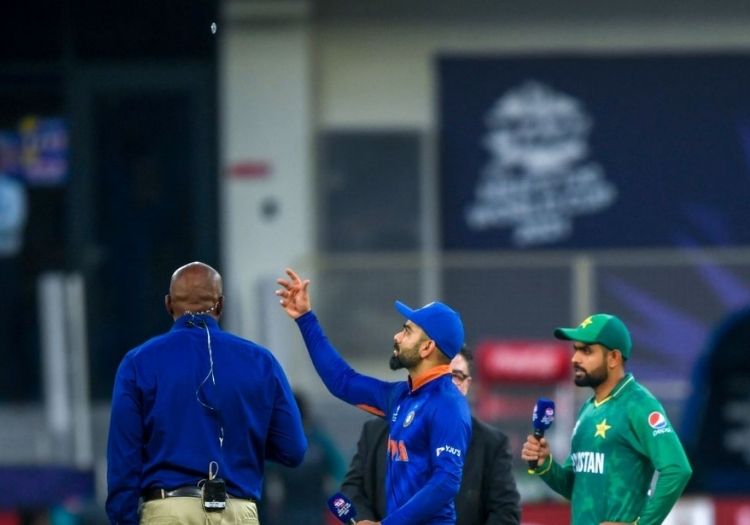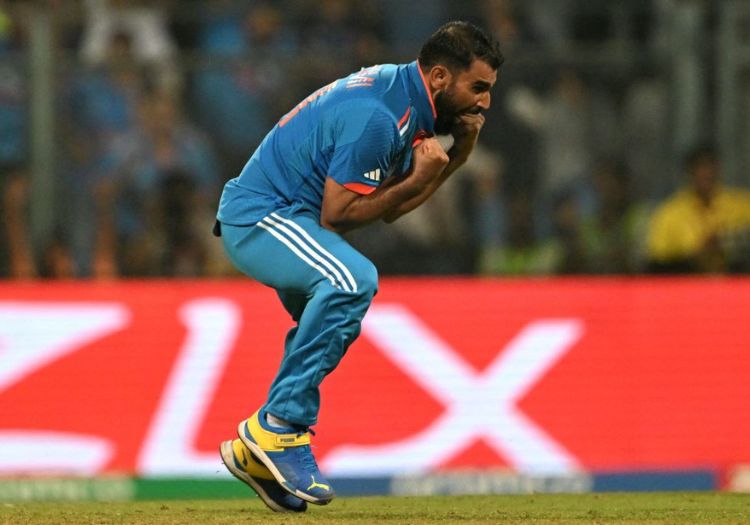NICK HOWSON: A tournament won by Australia but lacking thrilling moments threw up a number of talking points around the calendar and the significance of the toss

After seven wins for associate nations over full members across the last six editions of the men's T20 World Cup, 2021 saw two courtesy of Scotland's round one win over Bangladesh and Namibia's defeat of Ireland.
This was as many as we saw in 2016 and in 2009 and only one fewer than the record-breaking three we got in 2014 when we had Afghanistan to thank.
But it wouldn't be outrageous to suggest that the performances of the associates this year represented a step backwards. The Super 12s were a virtual walkover, highlighting the chasm that remains. They weren't contests that can be befitting of a world-class cricket event.
Preparation for this tournament was naturally disrupted due to Covid-19. Many nations, even some full members, saw their outings severely limited and this must be considered as a significant mitigating factor.
It is also worth noting that when they have been able to complete white-ball matches, they are so very often against each other. Namibia's opponents in 2021 were Uganda, United Arab Emirates, Scotland, Papua New Guinea and Oman prior to the tournament getting underway. No wonder they got through, but it also isn't surprising that is where it ended.
Exposure to full members at these tournaments is fantastic but how can we expect them to breach the gap and be consistently competitive if outings remain limited to showcase competitions? Without diminishing the achievement of making the Super 12s those matches need to be made to feel less like a lottery win.
Creating space in the calendar isn't the issue either, but using it better. England and India are playing a limited-overs series next summer for the third time in five years, for example. And it feels inevitable that Sri Lanka and West Indies will find a way to play each other again in 2022.
Associate nations have become a slight victim of their own success in these World Cup tournaments. They are not the soft touch they once were and are treated as such. Equally, the top teams are simply better T20 sides thanks to the sheer volume of franchise cricket being played.
World cricket has done a good job of integrating the associates in T20 cricket but this must remain an ongoing process.

Namibia and Scotland both produced upsets - but others struggled to be competitive
By the end of this week, India, New Zealand, Bangladesh, Pakistan, Sri Lanka and West Indies (the latter two in Tests) will be back in action. Because if you aren't playing cricket, can you actually claim to be a cricketer?
Gone are the days when a World Cup could be called the epicentre of the calendar, or even the most important thing within. It is now just part of the furniture and not even an important component: the footstool that you move around the living room to make space for everything else.
In short, there is now very little that is special about it. Notwithstanding the obvious issues around the 2021 event, it was smuggled between and IPL and more bilateral series. And there will be another one in 12 months times and a third of the decade in 2024. Australia feel like the interim champions.
The feeling that this was just another competition grows when you look at both the familiar cast, which bar obvious political infighting, rarely differs from tournament to tournament, and the quality of cricket on show.
You don't need many fingers to count the number of entertaining matches. Bangladesh's defeats to Scotland and West Indies, England edging Sri Lanka before losing to South Africa, Pakistan overcoming Afghanistan and both semi-finals. Few of the rest would even be vague contenders.
And how many more had genuine jeopardy behind them? Short of making the tournament a complete knock-out event, the lack of consequence was alarming. The final few days of the group stage in particular was a procession. Cricket for the sake of cricket.
Not until the calendar is diluted and the World Cup is given a proper window can it become the prestigious event that was originally intended. At the moment is it just part of the noise.
Forgive the variation on a theme.
Across four days either side of the tournament kicking off there were 16 warm-up matches.
Now while several nations have fed off scraps in terms of fixtures during the pandemic, this wasn't entirely true immediately before the competition. Many were involved in World Cup qualifiers or bilateral series organised immediately prior to the tournament. And then you have those nations who had players littered across the IPL.
Above all else, these matches discredit the upcoming event. While they were arranged so sides in the same group did not meet, it was inevitable they would be repeated come the second round or latter stages.
Two Super 12s matches, one semi-final and the final was contested during this period. Talk about devaluing your product.
There is a reason why Brazil and Argentina don't play each other in a friendly prior to a football World Cup. At least the authorities have worked out that when they do meet it should be special.
The horse may have bolted on cricket's attempts to make individual matches sought-after (India v Pakistan is a unique occasion for the wrong reasons) but it can at least try. Getting rid of warm-up matches feels like a relatively easy starting point.

The outcome of many matches were determined before play began
This World Cup simply had to take place. At least, that is how it felt. Crammed into a tight window in amongst all the other cricket this always felt like a necessary evil in the schedule.
Hosting it in Oman and the United Arab Emirates was an arrangement born out of convenience after the remaining matches in the curtailed IPL were shifted. Barring bubble fatigue, most of the big names would already be in place and would remain so. It made complete sense.
Staying within the realms of realism, pitches were not terrible. They didn't spin quickly as some might have thought and they didn't possess a great deal of pace but they posed different challenges, which is the whole point of a tournament. They stood up to scrutiny. Sharjah played host to the best matches, on the whole.
But it was immediately outside of that where the problem lay. Unless Pakistan, who have called the UAE a second home since the mid-80s, or India were playing, matches were dominated by empty seats and a sterile atmosphere.
That wasn't helped by those fans that did attend matches in Abu Dhabi being kept in pens like cattle, or by the rubbish attempts by the PA to initiate moments of crowd participation.
'CLAP! CLAP! CLAP! CLAP!'
And less said about the official song, the most overused piece of music at a sports event since Seven Nation Army, the better.
Obviously, the lack of sell-outs was heavily dictated by the pandemic and while we never want to see a repeat of the scenes during Pakistan v Afghanistan in Dubai when ticketless fans attempted to gain entry, droves of empty seats can't be repeated at an event of such prestige. The final in particular was a sorry affair, with almost as many dignitaries as fans of either side competing.
As restrictions begin to be eased in Australia, we can only hope for significant crowds when the tournament returns in 11 months time.

Fans were given access to every angle of the tournament
"It did play a big factor, to be honest," said victorious captain Aaron Finch. "I tried to play it down as much as I could because I thought at some point in the tournament I'm going to lose a toss and we'll have to bat first.
"But it did play a big part. You saw at the end there, the dew factor, the slow balls weren't holding in the wicket as much. I don't know how I did it. Maybe it was just fate."
He added: "T20 cricket, you need a bit of luck. Don't get me wrong; of course, you need a bit of luck, and like you said, we won six out of seven tosses, which goes a long way."
Let's not attempt to discredit Australia as worthy T20 World Cup champions. They played their best cricket at the right time. These tournaments do not crown the best team on the planet, just the team that cope with the conditions and whose players can achieve peak form at the right time.
Everything came together at the right time for the Aussies, including their fortune with the coin. Six out of seven times Finch called right and inserted the opposition. The only time he got it wrong they were walloped by England.
There were fears before the tournament that matches would ultimately come down to a flick of a coin. Dew was a factor that came and went but it perhaps didn't have the same impact as it had during the IPL. Towels weren't always visible and captains seldom complained about the change of conditions.
In the end, 29 of the 45 matches were won by the chasing side. In the 26 games played at night, when conditions are most open to changing from one innings to another, 16 prevailed batting second 14 of which won the toss.
T20 is regarded as a great leveller. Look across the biggest competitions and you'll see the title is not often retained year upon year. It has never happened in the T20 Blast or PSL, once in the CPL and IPL and twice in the Big Bash.
There are other factors at play, but the format creates unpredictability.
A look at T20 history in Asia suggests this tournament bucks a bit of a trend. Generally, the win rate for teams in Asia at night or during the day hovers at just over 50 per cent. You'll be hard-pressed to find a recent era that goes much higher, but it stood at 64 per cent for the 2021 tournament.
That doesn't mean cricket can't look at ways of levelling up. Changing balls at various intervals could work, though there are some slightly more wicked suggestions being floated. A magic envelope feels a bit too Brendan Rodgers.

Mark Nicholas was among the team of commentators
Introducing fresh innovations when you're desperately trying to push the tournament in a one-eyed way is a tough ask for the broadcasters and some ideas worked better than others.
Alternative camera angles, some often from within the crowd, and detailed tracking of the trajectories of shots were pleasant additions. But I doubt many went to bed that night wowing about the ingenuity.
However much the viewer might have tried, there was no ignoring the run box graphic which slid into view during quick singles and twos when the ball rolled out of the picture.
But instead of a bird's-eye view of the strip and both batters, it was a graphic interpretation. It was too close to Brian Lara Cricket for comfort.
There is a very good reason why run boxes have been fleetingly used in cricket coverage. It is very difficult to look in two places at once, as it happens, particularly when one of them is the actual ball.
Unlike virtually any other sport, cricket is constantly attempting to come up with a formula to deliver the key facts of the game to the viewer. No two matches are ever presented in the same way.
There isn't much point these days unpicking the performances of commentators and broadcasters during global events. It is ICC TV in action so they're merely toeing the line. In that sense, they're doing their job quite admirably.
Of those to stand out, Nasser Hussain and Mike Atherton were naturally very informative, Simon Doull captured both what drama there was with crucial insight and Shane Watson was a breath of fresh air.
Mark Nicholas is among the regular core of commentators. If you've switched on a major cricket match in the last few years and not heard his voice you've been doing it wrong. Or hit the mute button.
From questioning the attitude of players, including the "unusual" Adam Zampa, to declaring his disinterest in one day going into space, there was very rarely a commentary stint that didn't include a classic from his repertoire.

Mohammed Shami bowling in India's defeat to Pakistan
"Attacking someone over their religion is the most, I would say, pathetic thing that a human being can do."
When a cricketer has to condemn online abuse of a teammate, which included comments referring to religion, then you know there is a problem.
Online abuse reached an unacceptable level many years ago but has been allowed to slide by social media companies unwilling to tangibly change. Campaigns are gathering pace but real action has been few and far between.
Mohammed Shami didn't bowl particularly well against Pakistan. He deserves scrutiny in regard to his sporting performance.
That some online users took it upon themselves to blame him for the 10-wicket defeat due to his religious persuasion was a shameful move. Sport doesn't matter that much.
Tackling abuse via social media is a wider topic that cricket and certainly Virat Kohli cannot solve, but the alarms are sounding loud. No wonder sportspeople are so keen to release benign statements after matches when the reaction if they make an error is so full of anger. They have to get ahead of the game in an online world where you only exist if you have an opinion.